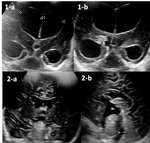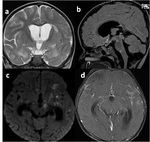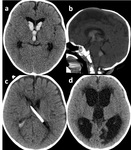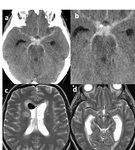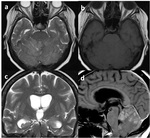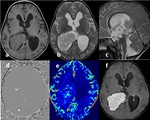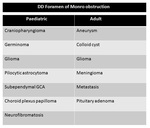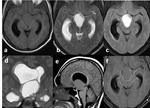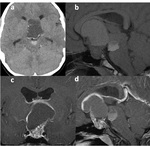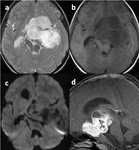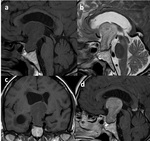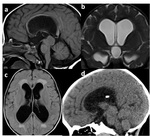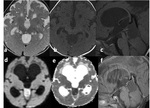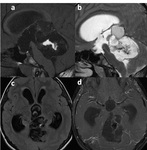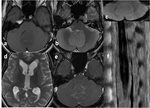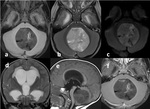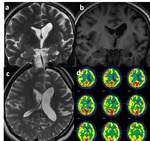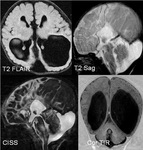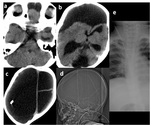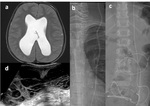Types of hydrocephalus:
- Communicating Unimpeded flow of CSF from the ventricular system into the subarachnoid space,
impeded absorption at arachnoid villi (1-a) Obstruction to CSF absorption

Fig. 6: Post menignitic communicating hydrocephalus
Child 1: 5 month/M, H/O Meningitis at 3months, now recurrent vomiting
1a, 1b- CHILD 1:
Neurosonogram- Anterior Fontenelle (AF) window, Cor: Showing Comm-HCP
Child 2: 1year/F , H/O Meningitis 1 month back, now increasing HC
2-a, 2-b- CHILD 2:
Neurosonogram –AF window, Cor & Sag : Showing Comm-HCP
References: Dr Anirudh Nair
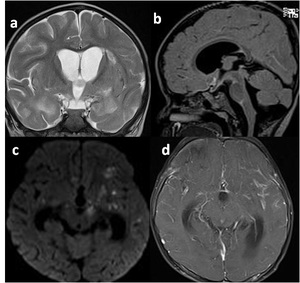
Fig. 7: Meningo-encephalitis with Comm-HCP in 1 yr/F; Presented with fever, projectile vomiting since 2 weeks. O/E left lateral rectus palsy, right hemiparesis, kernigs & brudenski positive
(a) T2 Cor: Hyperintense signal changes in temporal lobe bilaterally
(b) T1 Sag: Comm-HCP with prepontine hyperintensity
(c) DWI: Multiple focus of diffusion restriction-septic infarction
(d) T1 +c FS: Diffuse leptomeningeal enhancement
References: Dr Anirudh Nair
- Intraventricular haemorrhage (IVH)
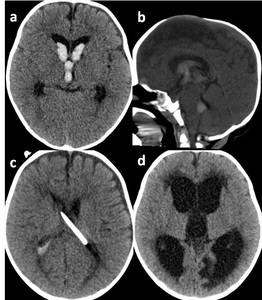
Fig. 8: IVH with Comm-HCP in a 6 month/F , H/O fall while playing
(a) CT axial : Intraventricular hemorrhage (IVH) at lateral ventricle, foramen of monro
(b) CT Sag: IVH with bulging anterior fontanelle (AF)
(c) CT axial: Post Emergency EVD
(d) CT axial: F/up after 15 days, Comm-HCP with periventricular ooze
References: Dr Anirudh Nair
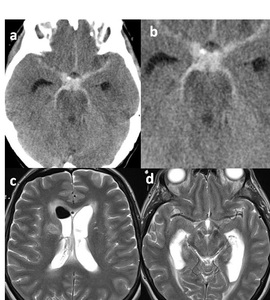
Fig. 9: SAH due to aneurysm rupture with Comm-HCP in a 56/F , Acute onset thunderclap headache
(a, b) CT axial : SAH with comm-HCP; DSA showed Aneurysm at junction of right ICA-PCA
(c) MRI T2W Axial: Post EVD with Comm-HCP and ventriculocephalus
(d) MRI T2W Axial: post VP shunting 15 days after coiling .
References: Dr Anirudh Nair
- Leptomeningeal carcinomatosis
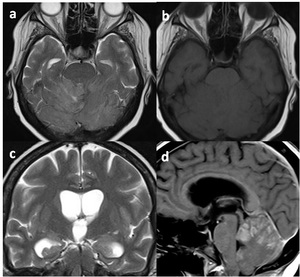
Fig. 10: Leptomeningeal, cerebellar mets with Non-comm HCP in a 63/F, K/C/O Carcinoma breast, presented with headache, ataxia & loss of consciousness
(a, b) T2 hyperintense, T1 isointense lesions at bilateral cerebellar hemispheres more towards superior aspect and vermis
(c) T2 -Cor: Dilated lateral & 3rd ventricles
(d) T1+c FS: Nodular enhancing lesions; obliteration of 4th ventricle
References: Dr Anirudh Nair
(1-b) Without obstruction to CSF absorption
- Normal pressure hydrocephalus (NPH)
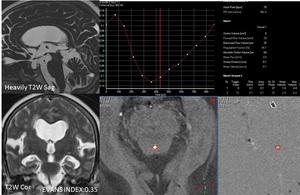
Fig. 11: Normal Pressure Hydrocephalus in a 62/F, gait ataxia, dementia, dribbling of urine
CSF flow study: Stroke volume - 32 mm3; Forward flow - 29 mm3; Backward flow volume - 35 mm3
References: Dr Anirudh Nair
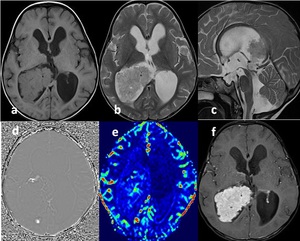
Fig. 12: Choroid plexus papilloma with Comm-HCPin a 1 year/M, Presented with bulging AF, difficulty in walking
(a) T1W Ax: Isointense IV occipital horn lesion
(b) T2W Ax: Iso to hyperintense
(c) T2W Sag: Dilated Lateral, 3rd and 4th ventricle
(d) SWI Ax: Blooming
(e) MR Perfusion: Moderate to increased perfusion
(f) T1+C Ax: Enhancing lesion
References: Dr Anirudh Nair
2. Non-communicating
Impedence to flow of CSF in the path of ventricles.
- DD for Foramen of monro obstruction
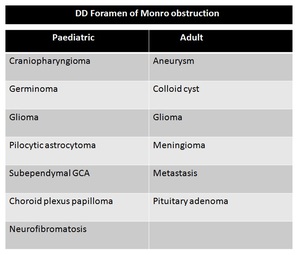
Fig. 13: DD Foramen of monro obstruction
References: Dr Anirudh Nair
- DD for 3rd ventricular obstruction
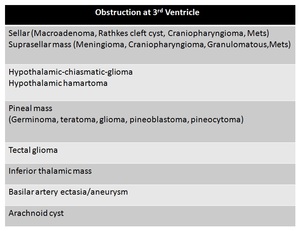
Fig. 14: DD for third ventricular obstruction
References: Dr Anirudh Nair
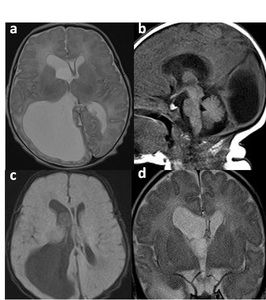
Fig. 15: Colloid cyst at foramen of monro(FOM) with Non-comm HCP in a new born, antenatally detected with cystic lesion at FOM with HCP
(a) T2-Axial: Hyperintense lesion at FOM towards right frontal horn with dilated right lateral ventricle
(b) T1-Sag: Iso to hypointense cystic lesion at FOM, Normal sized 3rd , 4th ventricles
(c) T2-FLAIR: Hypointense lesion at FOM
(d) Cor-TRIM: Dilated bilateral LV (R>L) , Right temporal horn
References: Dr Anirudh Nair
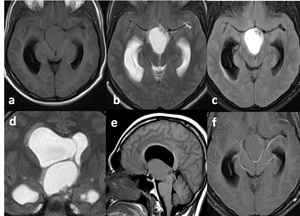
Fig. 16: Craniopharyngioma with Non-comm HCP in a 26/M, C/O headache since 3 months presented with projectile vomiting since the last 2 weeks
(a) T1 Axial: Isointense lesion
(b,c) T2 Ax, FLAIR: Hyperintense lesion with internal debris
(d) T2 Cor: Hyperintense lesion at suprasellar/FOM with LV dilatation
(e) T1 Sag: Suprasellar lesion, 3rd collapsed, 4th V normal
(f) T1 +c FS: No enhancement
References: Dr Anirudh Nair
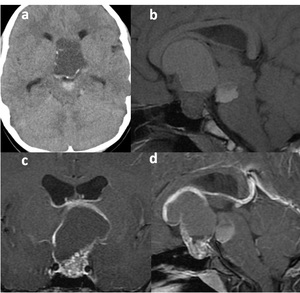
Fig. 17: Craniopharyngioma with Non-comm HCP in a 32/M, left side visual field defect, headache showing:
(a) CT Ax: Cystic Lesion with marginal calcification; Interpeduncular extension
(b) T1W Sag: Pituitary fossa splayed with T1 iso & hyperintense areas
(c) T1+c FS- Cor: Marginal enhancement
(d) T1+C FS- Sag: Enhancing solid component in pituitary fossae, superior rim, interpeduncular cistern
References: Dr Anirudh Nair
- Hypothalamo-chiasmatic glioma - Pilocytic astrocytoma
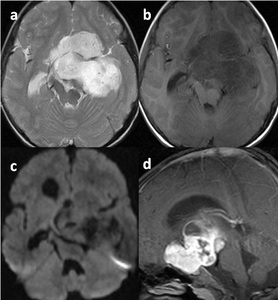
Fig. 18: Pilocytic astrocytoma with Non-comm HCP in a 3yr/M presented with right sided weakness since 1 month and history of one episode of seizure 1 year back.
MRI showing Lesion centred around optic-chiasmo-hypothalamic region extending upto FOM, appearing:
(a) T2 Ax: Hyperintense
(b) T1 Ax: Iso to hypointense
(c) DWI: No restriction with non-communicating HCP
(d) T1+C: good enhancement
References: Dr Anirudh Nair
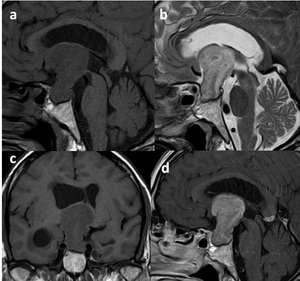
Fig. 19: Recurrent pituitary adenoma in a 64/ M , S/p resection 4 years back, now presented with unsteadiness of gait
(a) T1W Sag: T1 Hypointense lesion extending from sella into FOM
(b) T2W Sag: Heterogenously hyperintense
(c) T1W Cor: Hypointense; Non- communicating HCP
(d) T+C FS-Sag: Enhancement present
References: Dr Anirudh Nair
- Supratentorial and infratentorial extraventricular tumors causing ventricular obstruction- Atypical rhabdoid teratoid tumor
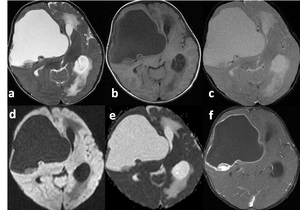
Fig. 20: Atypical rhabdoid and teratoid tumor with non-comm HCP of left lateral ventricle in a 1 yr/F presented with excessive vomiting since 3 days.MRI showing a Right frontal lobe lesion, appearing
(a) T1W Ax: Hyperintense
(b) T2W Ax: Hypointense
(c) GRE: No bloomimg
(d) DWI: No restriction
(e) ADC: Hyperintense
(f) T1+C FS Axial: Rim enhancement with enhancing mural nodule
References: Dr Anirudh Nair
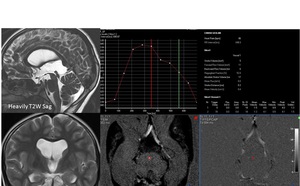
Fig. 21: Mild functional stenosis of cerebral aqueduct in a 10/F presented with headache since 2 weeks.
CSF flow study: Stroke volume – 4.5 mm3; Forward flow 6 mm3; Backward flow volume - 3 mm3
References: Dr Anirudh Nair
- DD for aqueductal obstruction
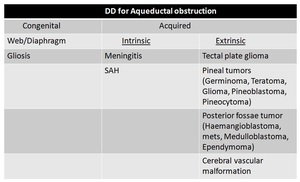
Fig. 22: DD for aqueductal obstruction
References: Dr Anirudh Nair
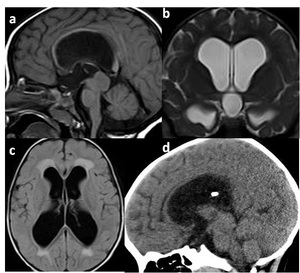
Fig. 23: Tectal plate glioma with Non-comm HCP in a 1 yr/M presented with delay in motor, language & social milestones and history of occasional vomiting
(a) T1W Sag: Tectal plate is bulky, appearing isointense. Aqueduct obliterated
(b) T2W Cor: Non-communicating HCP
(c) FLAIR Ax: Periventricular seepage
(d) CT Sag: S/p VP shunt, with shunt tip in lateral Ventricle
References: Dr Anirudh Nair
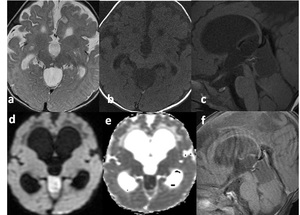
Fig. 24: Pineoblastoma with Non-comm HCP in a 4 month/M presented with history of lack of neck holding and downward gaze for 1 month and progressive increase in head size for past 1 week.
MRI shows lesion in the pineal region, appearing:
(a) T2W Ax: Hyperintense
(b) T1W Ax: Hypointense
(c) T1W Sag: Hypointense, isointense to CSF
(d,e) DWI & ADC: Diffusion restriction
(f) T1+C: Subtle internal solid component enhancement
References: Dr Anirudh Nair
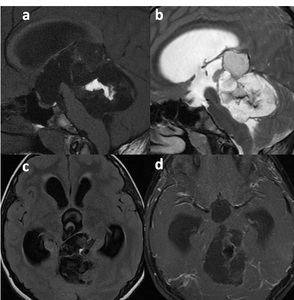
Fig. 25: Pineal region teratoma with Non-comm HCP in a 17/M presented with Headache, projectile vomiting, ataxia since the last 2 weeks
MRI showing, lesion at pineal region with mass effect over aqueduct:
(a) T1W Sag: Hyperintense streaks in center of lesion suggestive of fat
(b) T2W Sag: Hyperintense
(c) FLAIR Ax: Hypointense lesion with hyperintense internal streaks
(d) T1+C: Mild heterogenous internal enhancement
References: Dr Anirudh Nair

Fig. 26: Medulloblastoma with ependymal seeding and Non-comm HCP in a 29/M presented with history of giddiness, occasional vomiting, tinnitus in left ear since 2 months.
MRI shows lesion centered at 4th ventricle, appearing:
(a) T1W Ax: Iso to hypointense
(b) T2W Ax: Hyperintense
(c) GRE: No blooming
(d) T2W Ax: CSF seeding, nodules in ependymal lining
(e) T1+C- Axial: Zuckergauss enhancement
(f) USG Spine: No focal lesion
References: Dr Anirudh Nair
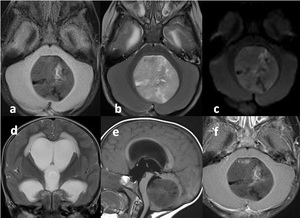
Fig. 27: Ependymoma with Non-Comm HCP in a 1 yr/M presented with recurrent projectile vomiting since the last 2 weeks
(a) T1W Ax: Hypointense
(b) T2WAx: Hyperintense
(c) DWI: Few areas of restriction
(d) T2W Cor: Non-communicating HCP with CSF seepage
(e) T1W Sag: Centered at 4th V
(f) T1+ C Ax: Minimal patchy enhancement
References: Dr Anirudh Nair
- Chiari malformation,
Type 1
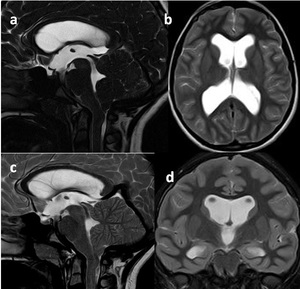
Fig. 28: Chiari malformation type-1 with Non-comm HCP in a 14/F presented with diplopia since 3 weeks. On examnination there was bilateral paplloedema with left 6th nerve paresis
(a) 3D CISS-Sag: Peg like hernination of cerbellar tonsil
(b) T2W Ax: Hydrocephalus
(c) T2W Sag: High velocity jet through aqueduct
(d) T2W Cor: Obstructive HCP
References: Dr Anirudh Nair
3.
Pseudohydrocephalus:
Ventricular dilatation that are not related to CSF dynamics.
- Ex-vacou dilatation of ventricles
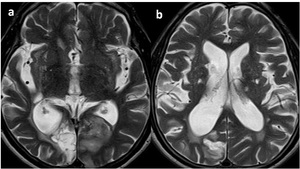
Fig. 29: Ex vacou dilatation of right occipital horn in a 60 Yr/M presented with acute on chronic PCA territory infarct
(a,b): T2 Axial images showing ex vacou dilatation of right occipital horn
References: Dr Anirudh Nair
- Dandy-walker Malformations

Fig. 30: Dandy walker varient with colpocephaly in a 1 Month/M; antenatally detected colpocephaly presented with recurrent seizures
(a) FLAIR: Corpus callosal agenesis
(b) T2 Sag: Colpocephaly
(c) CISS: Hypoplastic inferior vermis
(d) Cor-TIR: Mega cisterna magna
References: Dr Anirudh Nair
- Mesial temporal sclerosis
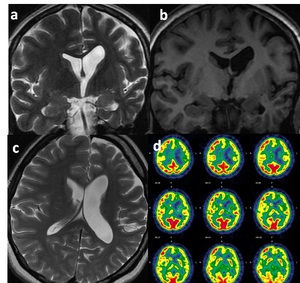
Fig. 31: Mesial temporal sclerosis with asymmetrical left ventricular dilatation in a 29/F presented with history of recurrent complex partial seizures since 1 year
(a) T2 W Cor, (b) T1W Cor, (c) T1W Ax: Atrophy of left- hippocampus, mamillary body, fornix, inferior frontal gyrus, cingulate gyrus, temporal lobe, thalamus, caudate nucleus. Abnormal T2 bright signal in left hippocampus. Asymmetrical dilatation of left lateral Ventricle (LV)
(d) FDG PET: Hypometabolism on left side
References: Dr Anirudh Nair
- Hydranencephaly: Hypolplasia/Agenesis of cerebral hemispheres to varying degrees and the remaining cranial cavity filled with cerebrospinal fluid
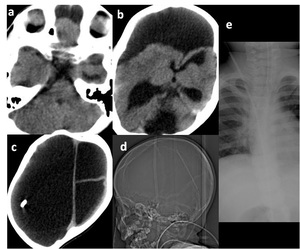
Fig. 32: Hydrencephaly in a 1 yr/F antenatally detected with large ventricular dilatation
(a, b, c) CT Axial- Dilated lateral ventricles, Supratentorial membraneous sac with CSF; right parietal VP shunt tip
,Left occipital lobe CSF filled area, Falx present
(d-Topogram& e- frontal Xray)
No shunt breaks/ disconnection
References: Dr Anirudh Nair
- Multiple congenital anomalies with ventricular dilatation.
Eg: Achondroplasia with ventricular dilatation
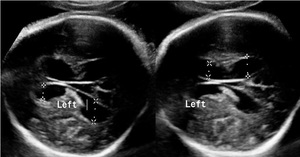
Fig. 33: Thanatophoric dysplasia with lateral ventricular dilatation in 37 weeks GA, Anomaly scan showing-polyhydramnios, hydrocephalus & skeletal anomaly.
(a,b) Antenatal Trancranial USG-37wks showing bilateral ventriculomegaly (>11mm)
References: Dr Anirudh Nair
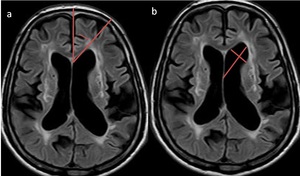
Fig. 37: Cerebral atrophy in a 70 year old male;
MR axial images (a) Ventricular angle tends to be smaller in hydropcephalus than in atrophy, (b) Frontal horn radius tends to be smaller in atrophy than in hydrocephalus.
References: Dr Anirudh Nair
Management of hydrocephalus:
Shunt types:
a.
Ventriculo-peritoneal (VP)
b.
Ventriculo-atrial (VA)
c.
Ventriculo-pleural (V-Pl)
LEARNING POINT: Proximal catheter tip ideally in frontal horn,
anterior to FOM,
away from choroid plexus4
Complications:
• Mechanical failure
• Infection
• Misplacement
• Overdrainage/Slit ventricle syndrome
• VP: Peritonitis, Peritoneal adhesion
• VA: Endocarditis, TR,
PAH,
PE, Intraventricular complications
• V-Pl: Hydrothorax
Shunt imaging
a.
Plain CT- Pediatric dose reduction protocol/ MRI (? Shunt MR compatible)
-Ventricular size difference on follow up
- Trans ependymal flow of CSF
- Edema adjacent to catheter
- Subgaleal fluid collections
- Reduction in periventricular white matter ADC value post shunt follow up

Fig. 34: NPH S/p VP shunt;Subtle decrease in periventricular white matter (WM) ADC values on follow up imaging, suggestive of reduction of edema post shunting in a 57/F with history of Ca breast S/p Right temporal lobectomy for metastasis
(a,c) Dilated Ventricles, periventricular WM hyperintensity- status quo
(b,d) ADC map
References: Dr Anirudh Nair
b.
Radiographs: (Skull-lateral,
Neck-AP & Lateral; Frontal radiograph- Chest & Abdomen)
•Breaks
•Disconnection
•Distal catheter migrations
c.
Ultrasound Abdomen:
•To assess intraperitoneal shunt tip,
and features of peritonitis/collection.
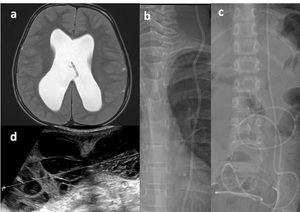
Fig. 35: VP shunt failure ; HCP with Intraperitoneal septated collection surrounding shunt tip in a 8yr/M, a known case of acqueductal stenosis; now presented with clinical features suggestive of shunt failure
(a) T2W-Ax: Hydrocephalus
(b,c) Frontal chest& Abdominal Xray: Patent shunt
(d) US- Abdomen: Septated intraperitoneal collection surrounding the shunt tip
References: Dr Anirudh Nair


